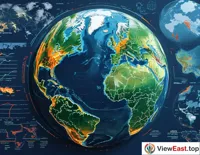







China's application of artificial intelligence (AI) technology is profoundly transforming the field of meteorological forecasting, bringing unprecedented accuracy. This article, through a series of exciting cases and data, comprehensively showcases the great achievements China has made in the field of AI meteorological forecasting.
1. Integration of AI Technology and Meteorological Forecasting
The China Meteorological Administration (CMA) actively embraces AI technology, continuously expanding its application in the meteorological field. Through the "Meteorological Artificial Intelligence Science and Technology Innovation Project Implementation Plan for 2024," the CMA coordinates the layout of the core technology research and development structure for meteorological artificial intelligence, promoting the construction of innovative platforms such as the meteorological artificial intelligence ministerial key laboratory. The launch and operation of the Xiong'an Meteorological Artificial Intelligence Innovation Institute marks an important step for China in the field of AI meteorological forecasting.
2. AI Technology Enhancing the Accuracy of Meteorological Forecasting
The application of AI technology has significantly improved the accuracy of meteorological forecasting. The National Meteorological Center focuses on weather monitoring, forecasting and warning, and product production, developing more than 50 artificial intelligence meteorological application models in four categories. The integrated application of these models has increased the 24-hour heavy rain scoring by 98% compared to the mainstream model, reduced the 24-hour typhoon path forecast error to 62 kilometers, and increased the accuracy of thunderstorm and short-term heavy rainfall forecasts by 8% and 13%, respectively.
3. Application of AI Technology in Climate Forecasting
In the field of climate forecasting, a team jointly established by the CMA and Fudan University has developed a sub-seasonal to seasonal AI climate forecasting model. This model can predict global temperature and precipitation anomalies 15 to 60 days in advance, with a forecasting skill 4% higher than that of the numerical forecast business model of the same period.
4. Application of AI Technology in Meteorological Services
AI technology not only plays a role in forecasting but also shows great potential in meteorological services. The "Artificial Intelligence Meteorological Application Work Plan (2023-2030)" issued by the CMA clearly defines the development roadmap for AI meteorological applications, promoting the deep integration of AI technology in meteorological observation, forecasting, and services.
5. Policy Support for AI Technology in the Meteorological Field
The policy support from the CMA provides a solid foundation for the application of AI technology in the meteorological field. Through the "Meteorological Artificial Intelligence Science and Technology Innovation Project Implementation Plan for 2024," the CMA not only promotes the development of AI technology but also establishes mechanisms for the integrated allocation of scientific and technological resources, the coordinated development of science and talent, and the integrated development of scientific research and business.
6. Technological Breakthroughs of AI Technology in the Meteorological Field
The three AI meteorological forecasting systems released by the CMA—"Feng Qing," "Feng Lei," and "Feng Shun"—target global medium and short-term forecasting, near-term forecasting, and global sub-seasonal to seasonal forecasting, respectively. These models demonstrate China's technological breakthroughs in the field of AI meteorological forecasting. The release of these models signifies a significant improvement in the accuracy and efficiency of AI meteorological forecasting in China.